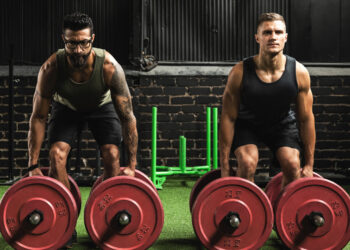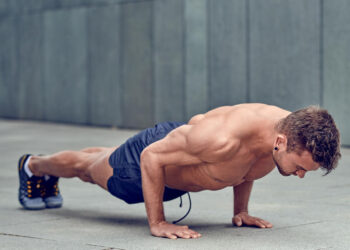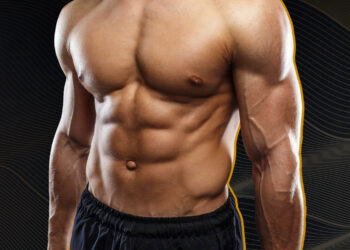Despite the popularity of all these new age ab building exercises, side crunches still remain a viable option to target the oblique muscles of the core. It’s a stupid simple exercise and according to research, crunches are still among the best for building a solid midsection. Not to mention, almost anyone can do them and reap the benefits.
Read more about side crunches, their benefits, best variations, optimal sets and reps, and how to keep progressing with this ab-focused exercise guide.
How To Do Side Crunches
Side crunches are a straightforward exercise without much variation in technique especially when performed on the floor where there’s limited range of motion. While you may find that everyone has their own unique style of training, a crunch is a crunch (with good technique).
Let’s go over proper form and movement execution of side crunches with detailed step-by-step instructions below.
Step 1: Starting position and set up
Grab an exercise mat or find a soft surface to lie on.
- Lie on your back with both knees propped up and feet flat on the floor.
- Drop your legs down to either side on the floor in a side lying position but keep your upper body at a roughly 45-degree angle to the floor. You don’t want to crunch laterally but at an angle where the obliques are located.
- Place the same side arm of the lifted part of your torso gently behind your head. Place the other hand on on your lower obliques.
Pro tip: Keep your head lifted and draw an imaginary line from your chin through the middle of your legs. Use this as a reference point to guide the direction of the side crunch.
Level Up Your Fitness: Join our 💪 strong community in Fitness Volt Newsletter. Get daily inspiration, expert-backed workouts, nutrition tips, the latest in strength sports, and the support you need to reach your goals. Subscribe for free!
Step 2: Crunch!
Crunches are simple yet they still get butchered. The key to effective crunches is letting the core muscles do all the work from beginning to end.
- Engage your core muscles and crunch your upper body in an upward and forward direction toward your knees to maximize core activation.
- Hold this position for two seconds, and slowly return to the starting position while keeping your obliques and abs tense throughout each and every repetition.
Check out the video example of side crunches below.
Related: How Many Calories Do You Burn Doing Side Crunches?
Benefits
Why would someone include side crunches in their workouts?
Emphasize the obliques
Having a six pack is high up on the list of most highly desired physical attributes pretty much anywhere in the world. And while the main abdominal muscles typically get all the attention and most of the focus, a solid pair of obliques accentuates a well-developed midsection.
Note: There’s a more detailed description of the obliques under the muscles worked section below.
Core exercise for all experience levels
Most people can do a basic ab crunch or the oblique-focused variation. But there’s a difference between being capable and doing an exercise effectively. Side crunches are a great beginner exercise but it does require a basic understanding of crunch technique.
Intermediate and advanced exercises can also benefit from doing high rep sets of side crunches.
Many advanced variation
Side crunches are very beginner friendly which means intermediate and more advanced exercisers will need something better to satisfy their strength requirements. There are many progressions and harder variations several of which we’ve listed under the variations and alternatives section.
Drawbacks
Every exercise has a disadvantage but it won’t necessarily affect your training progress. Here are some drawbacks of side crunches.
Needs a progression
When you can knock out 25 reps of side crunches without breaking a sweat it’s time to move onto something more challenging or add a variation to continue making progress. Otherwise, you’re just doing warm ups or getting in a cardio workout.
Pain in the neck
One of the most common mistakes people make when doing crunches is yanking and pulling on their head and neck… so is it an oblique workout or neck stretch? Your hands are there only to keep your arms out of the way when you perform crunches.
Common Mistakes
These are some things that people do wrong when performing side crunches.
Pulling on the neck – It’s one of the drawbacks of any bodyweight crunch variation that a lot of people and especially beginners are guilty of. Your neck is not a place to get leverage but rather a convenient spot for your hands to be, allowing you to move freely and comfortably during crunches.
Doing too many reps – We’ve all seen those people (and we were probably guilty at some point) who hop on the ab device at your gym and crunch for the same duration as a half-hour long TV show. If you want a cardio alternative it can work great. But that won’t get you better abs.
Not feeling it – Some exercises feel awkward to do and side crunches have the potential to be one of them. If you’re not positioned just right, failing to engage your core, or if something feels off then you might feel frustrated or like the exercise is ineffective. Well, you may be right.
Basic ab crunches are more straightforward (literally), but trying to fully stimulate the obliques may be a little more challenging. Use the written instructions and video example to help you do a proper side crunch.
11 Variations and Alternatives
The side crunch is a classic because of its simplicity and proven effectiveness. But these similar variations and alternatives have their own unique benefits and advantages.
1. Alternating side crunches
Instead of doing one side at a time, change it and alternate a left and right side crunch in a single set for the desired number of repetitions. You’ll probably benefit from enhanced overall core activation but it is harder to do.
Level Up Your Fitness: Join our 💪 strong community in Fitness Volt Newsletter. Get daily inspiration, expert-backed workouts, nutrition tips, the latest in strength sports, and the support you need to reach your goals. Subscribe for free!
2. Cross-body crunch
If the basic side crunch doesn’t feel stimulating enough, add some leg movement with a cross-body variation. It’s very straightforward, when you crunch, try to touch one elbow to the opposite side knee. Reset back to the floor and then do the same with the opposite elbow and knee.
3. Lower ab focused
To emphasize the lower portion of your obliques and ab muscles, assume the same position for side crunches but lift your feet a few inches off the ground. Now crunch your upper and lower body toward each other at the same time. You’ll increase the tension in your overall midsection and create a greater challenge for your core muscles.
4. Recliner oblique crunches
If you have access to a training bench, chair, or a similar object raised several inches off the floor, then you have another great oblique variation.
- Sit on the edge of your chosen platform and extend your legs out in front of you.
- Lean your torso back until it’s at a roughly 45-degree angle to the bench and turn your body halfway in either direction.
- Simultaneously crunch your torso and legs together squeezing your core muscles.
- Slowly return to the starting position and repeat or transition to the opposite side and alternate back and forth.
5. Decline side crunches
Let the downward forces of gravity create more resistance for your obliques by elevating your upper body on a decline bench. This is one of the easiest methods to increase the difficulty of a bodyweight exercise.
6. Weighted side crunches
If you’ve reached the 30-rep mark, it’s time for something more challenging. The simplest ways to increase the resistance are to hold a dumbbell (one handed) or weight plate (two handed). If you train at a gym, machines are also a top option.
7. Dumbbell side bends
A controversial exercise due to the common belief that it’ll overbulk the oblique muscles, dumbbell side bends are actually a phenomenal core movement. However, use one dumbbell instead of two. The latter counterbalances the resistance making it less effective.
Holding just one dumbbell forces your obliques to fight against it pulling you to one side, therefore activating the muscles opposite where the weight is held.
8. Stability ball side crunches
Floor crunches have their place but you’ll probably elicit more core activation by doing them on a stability ball which increases your range of motion and movement of the trunk muscles. This, should, in theory, yield better gains because you’ll get a better stretch and contraction in the obliques.
9. Cable side crunches/bends
Incorporating bodyweight, freeweight, cable and machine variations in your core workouts is going to maximize your results plain and simple.
But cables give you a few advantages over all the other options because you’re not locked in place like machines which activates more stabilizer muscles, yet the constant tension on the cables allows you to train from almost any position or angle. This allows you to focus more on the exercise and less on maintaining tension on the target muscles.
Cable side crunches and side bends allow you to train from an upright standing position which is how you’d normally function in nature, sport, or when completing everyday tasks.
10. Hanging oblique side raises
The weight of your legs is typically enough for a challenging core workout. Hanging side leg raises can be done from a pull-up bar or a power tower and there are many more versions of the movement within this variation.
If you want to add more resistance, straighten your legs, perform the windshield wiper variation or strap on some ankle weights and you’ll have some ways to progress this movement.
11. Cable wood chops
Possibly the best oblique exercise with cables, wood chops are done on your feet making them a functional core strength building exercise.
Programming Side Crunches
How you incorporate side crunches in your workouts depends on your level of training experience and goals. It doesn’t have to be complex, however, here are some suggestions of how we would do it.
- Warmup: Side crunches are a good pre-exercise warmup before doing a workout that involves the core muscles.
- Finisher: Unless they’re your only option, side crunches are best saved after hanging leg raises, cable work and other resistance based ab training. Finish them off with a few high rep sets.
- Bodyweight-only ab workout: Warmup with side crunches and if they’re not challenging enough, incorporate a variation.
Sets and Reps
It’s harder to assess and prescribe the perfect sets and rep range for bodyweight based exercises because the resistance is, well, YOU. It cannot change unlike weights or machines. Therefore, a common strategy is to max out your performance on a bodyweight exercise then add more weight via various methods (e.g., adding weight, changing body angle, or using a more advanced variation).
For the basic bodyweight side crunch, we recommend 2-4 sets of 10-30 reps.
When you can do more than thirty reps, consider a more advanced option.
Muscles Worked
Below we’ve included a brief section on the anatomy of muscles involved in side crunches.

Obliques
Your side core muscles, the obliques are located on the lateral torso on either side of the abdominals. These muscles allow us to twist to the left and flex the trunk or bend sideways with help from the abdominals.
Rectus abdominis
When you think of a washboard stomach these are the muscles that create the lumpy appearance. Rectus abdominis also known as your abs are the front, center core muscles and their job is trunk flexion (curl the upper body down or sideways.
Bottom Line
Regardless of your training experience, side crunches (or its variations) are a classic oblique exercise that has its place in any core workout regime. If you want to target the “boxer’s muscle”, the variation included in this exercise guide is the easiest way to get it done… no equipment needed.
But remember, it’s also a bodyweight-based exercise that can lose its potency over time. So you need to know when and how to use more advanced techniques to keep the gains comin’.
Interested in measuring your progress? Check out our strength standards for Side Crunch, Side Leg Raise, Hanging Leg Raise, and more.









